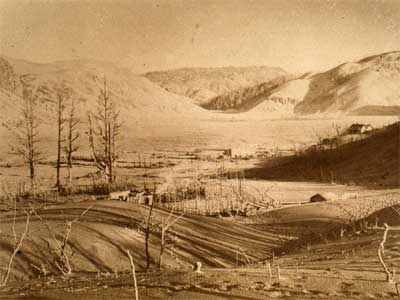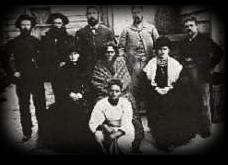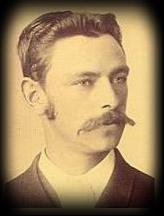|
|
|
|
Connie Annally: found herself crouching under a table at Tarawera while the earth around her thudded and trembled and ash and mud piled against the whare walls threatening to engulf them all. In the morning she was dug, still breathing, from her dark tomb. |
 |
 Survivors from Te Wairoa |
William Bird: a guest at the Hotel Rotomahana, Te Wairoa, on that fateful night quoted "Lake Tarawera was a copper mirror, reflecting the mount from base to summit in a lurid glare. Dominating all, hung the great cloud-curtain, gloomy and dark above, saffron and orange on its under-surface. From the cloud, great balls of flaming rock dropped from time to time, descending with a splash into the waters of the lake. The awe of the watchers quickly turned to fear. A hail of stones began to rain down, and a strong wind accompanied by a deafening roar of smashed windows". |
|
Terima, a Maori woman: When we saw the fire coming, we thought it was death for all of us. Most of the houses were flattened down in a short time, and only two were left. When I ran out of the house I was knocked down three or four times, and received severe cuts on the head. |
 |
.jpg) |
Major William Gilbert Mair: All around Rotoiti everything was covered with the grey volcanic deposit...The telegraph lines were coated, and looked like ropes an inch thick. Numbers of staight dead tree- trunks were burning like torches. |
|
Read this eye witness account by one of the rescuers: "The largest and most strongly built of the native habitations was that of the chief guide [Guide Sophia]. This had a substantial ridge pole and thus offered more resistance to the weight of the deposit falling upon the roof. It happened, too, that to provide a cleaner approach in wet weather, the guide had laid down a footway of strong nine-by-two-inch planks. When the ridge-pole began to bend ominously and show signs of snapping these were brought in and used as props. This precaution no doubt proved a wise one for, so far as could be seen, this roof was the only one that did not collapse. Within the building a large number of people [over 60], both Maori and European had taken refuge, so that, but for the use of the planks, the death roll would no doubt have been much larger. "McRae's Hotel, at which we had dined on my previous visit, to the village, was a mass of ruins. When it began to collapse Mr McRae and a guest who had remained after all others had quitted the building decided to make for the house of the Maori guide not many yards away. The proprietor, thinking his companion was following at his heels, did not look back but was greatly surprised on reaching the hut to find that he was alone. So intense was the blackness that it was impossible to locate the missing man, and for many days afterwards no trace of him could be found. Ultimately a searcher, combing over the ruins of the hotel, saw part of a hand protruding from some broken timber, and the remains of the unfortunate visitor were found pinned under the debris of the collapsed balcony. Obviously this must have fallen at the moment the pair left the building and missed the proprietor by inches." |
 Philip Frank Hannken shopkeeper and eyewitness. |